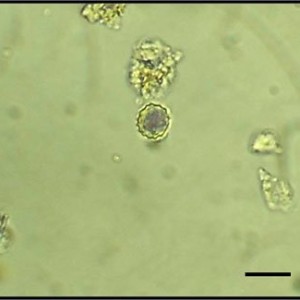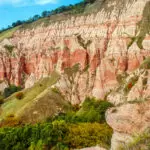
Phytolith studies require an understanding of several disciplines at once. Though the method is used primarily as a tool of archaeology and anthropology (the study of humans in the past) it does require a solid background in plant biology. Therefore, people who go on to research and study phytoliths will often have a heavy focus on ecology, botany or geography. There are no degrees in phytolith studies and because of the specialised nature of the research and the level of specialist knowledge required, and the limited number of positions because of the level of that specialism, most roles will require a Master's Degree or greater. Typically, research roles will require a Doctorate. Most graduates will end up in research roles in universities or for environment related non-profit organizations and in the private sector as lab technicians and in the agricultural sector.
The evidence is largely used to indicate natural changes and those caused by human engineering of the ancient ecology (the palaeoenvironment), so it is from studies of elements of the human past from which most researchers enter the field. As we are now trying to understand our future by looking at the past (1), it is growing as an evidence type right across the board for environmental science - environmental archaeology, palaeoclimatology, human geography and associated fields.
What is a Phytolith?
Phytolith is the combination of two Greek terms - “plant” (phyto) “stone” (lith). When a plant absorbs water from the ground, it will also absorb the nutrients that it needs to live, breathe and reproduce. Nutrients are vital to the plant's survival, and because of the chemical make-up of some types, will leave a residue long after the individual plant has died and been absorbed back into the ground as nutrients for the next generation (2). Silica, calcium and opal are minerals absorbed into a plant's cells whether they need them or not; the skeleton left behind following decomposition that indicates plant remains in those areas where those minerals are present. The skeleton ends up, along with the decomposing plant, back in the silt (4).
Phytoliths are tiny - no larger than a single plant cell, perhaps between 10 and 70 microns across (4) and therefore may only be seen through a microscope; as the cells in most types of plants have a specific and identifiable morphology - though not always (7, p56) - we can identify which plant was present. Fortunately, silica exists in the ground of most soil types (unlike calcium and opal) and is absorbed mostly into the plant walls and in the specialised cells (3) so we can tell from which plants the phytolith remains originated. When we talk about phytoliths, we are mostly talking about material composed of silica. Phytoliths are inorganic and therefore in those soils where they form, may survive indefinitely. It is important to note that though phytoliths will form in most soil conditions, they will not necessarily always survive. Any soil that is strongly calcareous (chalky areas where hard water forms) drastically reduces the survival rate of phytolith remains (5, p165). They can be easily destroyed in soils with a strong pH (1).
Most commonly, researchers find phytolith remains of grasses and of flowering plants; wood and bark are fairly uncommon, but not rare. There are examples from caves in Israel demonstrated the types of wood that were burnt by human inhabitants in the Palaeolithic (6, p477).
A Brief History of Phytolith Studies
Though The Enlightenment saw a massive expansion in the physical sciences and botany had been an area of interest for hundreds if not several thousand years (but particularly since the Renaissance), it wasn't until 1835 that anybody studied phytoliths specifically (8). Most interestingly, their study predates palynology (the study of seeds, spores and pollen) by at least a year.
Charles Darwin identified a number of the plant microfossils we now call phytoliths (2). His interest began while on The Beagle when he studied the dust blown onto the ship off the coast of the Cape Verde Islands. Because of his larger project while on the trip, he simply described what he saw and formed his own opinion on what they represented on their own and in terms of plant evolution. Darwin passed his dust samples onto a friend and throughout the course of the later 19th century, several seminal works were published (8) that would form the backbone of research into the early 20th century.
There would not be any more significant advances until after World War II. In the US, Russia, UK and Australia significant advances were made. It was Smithson of The University of Bangor (Wales) who identified the potential study of the then growing science of ecology (9, p336-7). He realised that these plant remains could tell us much about the palaeoclimate and the palaeoenvironment, particularly the effect that human action in the past could have had on the local environment. The morphological variety of the landscapes of these countries meant that in a short space of time, many areas were investigated. In the USA and Australia in particular, the large amount of virgin land meant that researchers could study phytolith remains (9, p337) in geological deposits much older than researchers in Europe could study.
Later still, researchers began searching through organic remains of known human sites - looking at hearths and ceramic remains, amongst other things, for evidence (8) and since then, archaeology and ecology have become intertwined (9, p337-8). To many, this was likely the beginning of when the study of humans in the past became as much of an environmental study as it was of history (9, p338). Works from the 1970s to the late 1990s firmly established the data as useful in archaeology and anthropology. Today, phytolith studies remain an essential tool of archaeology, anthropology and the environmental sciences (8).
What Do They Tell Us?
Mostly, phytoliths tell us about the environment of the past, and in the last few decades, especially how humans engineered landscapes for farming (3) and when the process began in any part of the world (4) - giving us a more complete picture of the Neolithic Revolution. Ecology and the environment have played a much larger part in the sciences of the last few decades for reasons too numerous to list and which are outside the scope of this article. When it comes to both natural and human processes and changes to the environment, it is as important today to understand the “why” and the “how” as much as it is to understand the “when” and the “what”.
In the last few decades, phytoliths, along with other plant remains such as pollen and seeds have been fundamental in reconstructing the environment of the past. They have proven particularly useful in studying the development of agricultural systems of humans of the past and their spread across the globe (10, p739). This means that it is important for researchers to be able to identify which plant remains come from which known plant species. This is not always easy to do, it is understood that some phytolith remains are so similar that it is difficult to tell different species apart. This can make reconstructing the ecology at any point in the past particularly difficult (9, p339-40). This is why we study not long different types of phytoliths and as much data as we can, but also incorporate other data sets such as pollen. Nevertheless, there is a huge amount of data already in this area despite being a relatively young discipline compared to other botanic and plant microfossil studies.
Similarly, we must be careful in relying on phytolith data too much; some plants are over-represented in the record because of the amount of ground nutrients they absorb, or because of the types of soil they live in which is more conducive to phytolith creation and survival (9, p338-9). There is a very real danger that we could misrepresent an ecological record of the past simply because of this varied survival rate.
We do not just look to the soils either for phytolith evidence. A number of human bodies - where the remains have found ideal conditions for preservation of the evidence - have revealed phytoliths in the teeth. Naturally, such evidence helps us to determine the diet of the person (4), once again adding to our understanding of the local ecology and the human interaction with it. They can also tell us about the types of plants and trees used by humans in crafting and in fire burning (6). We cannot always tell whether phytoliths obtained from plant remains were the result of natural brush fires or human action though (7) - this can be a problem for anthropologists looking for answers to a specific question about a habitation zone and what impact human populations had.
There is some debate about the usefulness of information acquired from weed species when associated with cultivation zones. Some researchers argue that weeds could and did play an important part of the cultivation of crops (10, p740-743). Often this information has been discarded as weeds are unwanted contaminants, but in some studies, some have proven beneficial in the cultivating process.
As well as learning about the environment and natural processes of the past, and about humans and human engineering, phytoliths can teach us about the plants themselves. Plants absorb silica and other minerals for many reasons and it has come to light in several studies that some do so because it hardens the cells and gives them protection against infection from certain fungi. It has also been suggested that this hardened skeleton may aid plant metabolism in absorbing other nutrients (3). There is also some evidence to suggest that some plants absorb silica as a defence mechanism against herbivores (9, p337; 11) - the plant flavour is adversely affected when it absorbs a lot of silica, making it unpalatable to herbivorous plants that would then move onto other plants that do not absorb as much of the mineral. Phytoliths then, provide three vital functions for the plant:
- Making the plant stronger
- Controls and regulates the absorption of minerals and heavy metals
- Protecting the plant against disease and herbivores
These three issues (12) have massive implications for the study of plants in themselves outside of the environmental, ecological and archaeological data. Understanding which soils are and are not suitable for certain plants and crops can help us better understand our own environment and details from phytoliths from the palaeoclimate record will tell us which respond better to certain environmental conditions (4) and which will struggle to survive.
Phytoliths do have their drawbacks; we have mentioned above the problems of over-representation of certain plants and those phytoliths from certain cells. However, despite this, they are a better indicator of plant density than palynology due to the erratic nature of survival rates of pollen and spores and the comparatively limited ways in which those plant remains survive (7, p58). Together, we can reconstruct and get a clearer sense of the palaeoenvironmental record.
Sources
- http://history.org/Foundation/journal/Autumn06/tech.cfm
- Wilkinson, K. & Stevens, C. 2003: Environmental Archaeology: Approaches, Techniques & Applications. Stroud: Tempus
- https://www.researchgate.net/publication/235933500_Quantitative_Phytolith_Study_of_Hearths_from_the_Natufian_and_Middle_Palaeolithic_Levels_of_Hayonim_Cave_Galilee_Israel
- Zucol, A.F., Brea, M., & Scopel, A., 2005: First record of fossil wood and phytolith assemblages of the Late Pleistocene in El Palmar National Park (Argentina). Journal of South American Earth Sciences 20 p33-43
- http://archaeobotany.dept.shef.ac.uk/wiki/index.php/Phytoliths_-_Introduction
- Egan, D. 2001: The Historical Ecology Handbook: A Restorationist's Guide to Reference Ecosystems. Island Press: Washington DC
- http://www.homepages.ucl.ac.uk/~tcrndfu/articles/HarveyFuller.pdf
- https://academic.oup.com/aob/article/102/4/653/165634
- http://ir.uiowa.edu/cgi/viewcontent.cgi?article=1610&context=etd
- Guide to Parasitology - November 19, 2018
- Deserts as Ecosystems and Why They Need Protecting - November 19, 2018
- Conservation: History and Future - September 14, 2018
Related Articles
Featured Article

How Does Radiocarbon-14 Dating Work?





